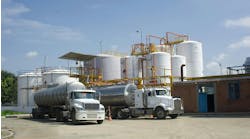Can tire balancing compounds - often called "tire balancing beads" in industry parlance - truly extend usable tire life while providing fuel savings at the same time?
That’s what the engineers at IMI Products believe and they put the company’s new Equal Flexx "balancing compound" package – introduced earlier this year at the Technology & Maintenance Council (TMC) annual convention in Nashville, TN – to the test during a special demonstration event for reporters held at the firm’s new headquarters in Chambersburg, PA, this week.
Taking two almost identically spec’d rental Class 8 tractors – with even their maintenance records a near spot-on match – IMI put pouches of its Equal Flexx polymer and elastomeric compound in the steer and drive tires of one of the trucks while leaving the tires on the other untouched.
Special sensors mounted to the wheel hubs of the tractors also allowed IMI’s engineers to show how the Equal Flexx compound helps reduce vibration at the wheel end, creating a smoother ride for the driver while evening out tread wear – promoting longer tire life and fuel savings simultaneously, noted Bob Fogal Jr., the firm’s president and CEO.“Over the course of a tire’s life, regardless of position, it’s going to lose rubber and wear unevenly. You’re looking at losing anywhere from 25 to 30 lbs. of rubber over a tire’s life due to wear,” Fogal (seen at right) told Fleet Owner.
“So the key is to get a better ‘footprint’ with that tire, because as it wears more, it becomes more fuel efficient due to lower rolling resistance,” he added. “Thus the reason balancing the tire becomes critical is that more even wear extends the life of that tire in its ‘sweet spot’ for fuel economy.”
John Tak, IMI’s director of marketing and product development noted that the development of just the right kind of tire balancing compound in terms of shape and material composition "is a complex science" with "a lot of nuances" to account for.
Yet the extensive testing by IMI's research team – headed up by Steve Ludwig, the firm’s senior product development engineer and an aeronautical engineer by training - concluded that tire balancing compounds can improve the fuel efficiency of longevity of tires in all wheel positions on a tractor-trailer. IMI noted that lessening rolling resistance of tires is the main avenue for fuel savings, and showed that trailer tires are responsible for the largest portion of rolling resistance on a tractor-trailer:
- Steer tires are responsible for 18% of a tractor-trailer's rolling resistance; using balancing compounds in this tire position can result in $1,000 in annual fuel savings for a tractor-trailer accumulating 100,000 miles a year, averaging 6.5 MPG and paying $2.50 per gallon for diesel;
- Drive tires are responsible for 39% of the rolling resistance; improvements here can lead to $2,100 in yearly fuel savings;
- Trailer tires accord for 43% of the tractor-trailers overall rolling resistance; thus improvements here can result in $2,400 of fuel savings per year.
Altogether, fleets can save $5,500 in fuel costs annually by using tire balancing compounds, IMI noted, when measured against the $450 total cost of adding Equal Flexx packages to all the tires on an 18-wheeler – a figure that derives from 25% more tire life and a 3% to 5% improvement in overall fuel economy due to lower rolling resistance, noted Derek Forney, IMI’s associate product manager.
Those kinds of numbers mean that fleets should experience a return on investment (ROI) of three months on average by using Equal Flexx, noted Fogal.
He added that one of the “best parts” about such balancing compounds is that they help tires adapt to their conditions, balancing them if stones are caught in the tread, or there’s a lot of mud or snow and ice on the road.
“It’s also a ‘one-and-done’ application,” Fogal pointed out, with the Equal Flexx pouch dropped in at tire installation, breaking open to release the compounds inside once installed. “That’s why it’s a cost effective solution.”




